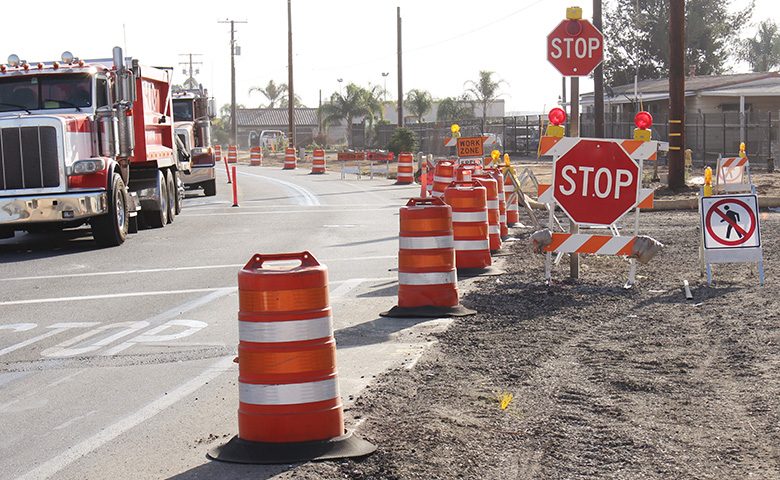A roadway worksite is a high-risk workplace that requires careful, detail-oriented preparation and clear and consistent training and messaging to all workers on site to guard against incidents. The presence of cars traveling at high speeds through the worksite, combined with working alongside large construction, can present a grave risk to workers on the ground. An average of 105 workers lose their lives each year as a result of pedestrian fatal injuries at road construction sites. The majority of fatal incidents are caused by a worker being struck by a vehicle in the work zone. To reduce the risk of injuries and other safety incidents on your construction site, consider these three ways to improve road construction safety.
Make sure workers know your vehicles
The rollers, graders, excavators, dump trucks and other construction vehicles often used for road work are extremely large—which means they have huge blind spots—and are operated in relatively tight spaces. To get the job done, people often have to work in close proximity to construction vehicles, and these workers are vulnerable to serious injury. To guard against an incident taking place, educate employees on the construction vehicles that will be present on the job site. The following safety measures on construction sites are all highly recommended:
- Workers should be made aware of the blind spots, turning radius and other relevant characteristics of common vehicles on the jobsite.
- Make sure everyone knows the vehicles’ relevant safety features, including brakes, lights, horns and reverse alarms.
- A pre- and post-operation checklist must be completed for every vehicle in order to ensure safe operation.
- Complete and document regularly scheduled maintenance.
- Ensure that annual inspections are done by a reputable service.
- Confirm that all drivers are appropriately licensed and are experienced in driving the specific vehicle in question.
Take the steps necessary to familiarize workers with the vehicles they are working in and around. If it’s been a while since this training has happened, you may want to consider providing refresher training or offering reminders in the form of a toolbox talk or short safety meeting.
Establish a safety-centric standard operating procedure
According to the Bureau of Labor Statistics, 89 worker deaths caused by vehicles backing up on the jobsite were reported between 2011–2017. This unfortunate statistic underlines the importance of establishing a detailed and comprehensive standard operating procedure. This will allow the worksite managers to take all the guesswork out of your employees’ workday and get everyone on the same page. The focus should be on developing procedures that highlight worker safety and minimize instances where workers are required to be in proximity to heavy machinery and equipment. One habit to emphasize is for vehicle operators to always communicate their intent. That way everyone knows where an in-use vehicle is and what it is doing, and thus can give it a wide berth. Other recommended controls include:
- Using equipment designed to have a reduced blind spot, or that have enhanced safety features such as proximity warning systems.
- Requiring the use of high-visibility work apparel and relevant PPE.
- Designing the worksite to minimize the backing up of vehicles and equipment, and reducing instances of employees working in close proximity to vehicles.
- Ensuring experienced managers are on site to oversee and troubleshoot issues as they occur.
- Taking extra precautions for workers on foot as they are particularly vulnerable; establish worker-free zones if necessary and direct vehicle flow away from worker areas.
- Designing and implementing comprehensive procedures for when backing up vehicles on the site, and establishing communication systems where there is constant contact between driver and spotters.
Additionally, site design should provide maximum space between active motorists and the worksite. Personal vehicles should be in designated parking areas only, and never driven through the worksite.
A strong standard operating procedure is paramount to preventing incidents on any job site. Be sure to develop the procedures with the input of experienced workers, as their experience and perspective can be of great utility. Once established, all workers should be trained on the procedures and made aware of all details; the procedure is only effective when workers know and understand it.
Fight against distracted driving
In a few short seconds, a distracted driver can quickly cause catastrophic injury. Guarding against distracted driving should be a point of emphasis—watch this quick and informative webinar to get up to speed. Recommended prevention strategies include:
- A zero-tolerance policy on phones, tablets or other devices, or the consumption of food or drink in the cab of any vehicle on the worksite.
- Investing in human factors training for workers and supervisors, as unchecked human factors raise the risk of an incident dramatically. If you’re not overly familiar with how human factors can circulate in the workplace and cause all sorts of safety issues.
- Have supervisors or experienced workers lead toolbox talks regarding distracted driving and its risks. Try to incorporate real-life anecdotes so the messaging is more likely to connect with workers.
There are countless examples of how distracted driving can lead to harmful incidents; it’s in the best interest of everyone involved to take the risk seriously and guard against its occurrence.
Don’t let the high risks of roadside construction lead to a culture of apathy and complacency. Use these three strategies to show that your company is serious about protecting workers. By developing a safety-centric operating procedure, your company will be sure to cut down on incidents and have a happier, safer and more productive workforce.

